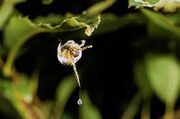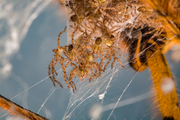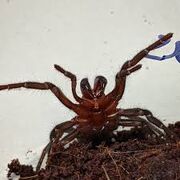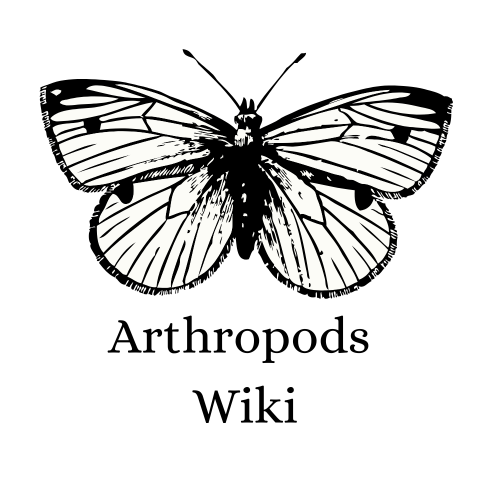For a page concerning taxonomic classification, see Araneae. For the category (list of species/genera) see Category:Araneae.
Spiders are a unique and diverse group of arachnids, comprised of over 45,000 species and over a hundred families with an established population on every continent with the exception of polar regions. their distribution isn’t static ; being most abundant in Australia and least in Iceland. Spiders are best known for their ability to produce silk which emanates from the rear of their abdomen.
Morphology[]
Spiders have bodies divided into two segments I.e the cephalothorax which bears the poison-producing glands, Chelicerae, simple eyes and the brain (Ganglion). and the abdomen which bears reproductive, digestive, excretory organs as well as the silk-producing glands and the heart. All spiders have eight legs, their eyes are quite simple, generally most species have eight eyes however some do possess 6 for example, sowbug spiders. Their eyes are arranged in rows. Their forelimbs are modified into a pair of pedipalps which aid the spider’s spatial perception. Spiders, most notably web-building spiders possess elongated setae known as trichobothria which aid in navigation allowing the spider to feel airborne movements, motion of prey items on any surface or even sound waves. Spiders have fangs (chelicerae) which can deliver a venomous bite which helps subdue prey. Some species such as purseweb spiders have large, exaggerated fangs. Albeit not all species are dangerous towards humans. Some species have highly-adapted and powerful eyes, generally applied in the case of spiders which actively pursue their prey instead of utilising webs such as jumping spiders. They lack antennae which are observed specifically in Insects and wings.
Colouration[]
Coloration is usually very distinctive from one species to another. Certain species have highly exaggerated and vivid colours for example Typhochlaena seladonia ( Brazilian jewel tarantula) whereas other species have an all-inclusive sombrely hues coating their bodies.
Sexual size dimorphism[]
This refers to the difference between the size of either sexes in any animal, spiders are a great example of such with females often being significantly larger than males this odd adaptation mainly has to do with reproduction, males actively seek mates during the breeding season what aids them in doing so is a process known as bridging. A smaller size also enable “ballooning” which is another method of locomotion.
Ecology[]
Silk[]
Spiders are well-knownfor their ability to produce silk which usually emanates from the rear of the abdomen, from hose-like organ’s called spinnerets, The abdomen has no appendages except those that have been modified to form one to four (usually three) pairs of short, movable spinnerets, which emit silk. Each spinneret has many spigots, each of which is connected to one silk gland. There are at least six types of silk gland, each producing a different type of silk. The silk is made of proteins, constructed intricately from innumerable microfibres, this enhances the durability of the silk, Some spiders have a cribellum, a modified spinneret with up to 40,000 spigots, each of which produces a single very fine fiber. The fibers are pulled out by the calamistrum, a comblike set of bristles on the jointed tip of the cribellum, and combined into a composite woolly thread that is very effective in snagging the bristles of insects.
Adhesion[]
Spiders do not usually adhere to their own webs,When observed under a microscope, adhesive silk strands are made up of hundreds of microfibres strudded with droplets of glue which provides adhesion to the sticky parts of the web. Because they are able to spin both sticky and non-sticky types of silk, and are careful to travel across only non-sticky portions of the web. However, they are not immune to their own glue. Some of the strands of the web are sticky, and others are not. For example, if a spider has chosen to wait along the outer edges of its web, it may spin a non-sticky prey or signal line to the web hub to monitor web movement. However, in the course of spinning sticky strands, spiders have to touch these sticky strands. They do this without sticking by using careful movements, dense hairs and nonstick coatings on their feet to prevent adhesion.
Webs & Web types[]
Spiders are also known for their ability to utilise their silk for construction of intricate structures known as webs. Spiders utilise webs in a myriad of ways, generally two-dimensional structures composed of overlapping threads forming an intricate and wonderful network of threads, The structure of a web varies greatly from species to species some species build incredibly dynamic three-dimensional webs, irregular webs expanding from point A to point B. Funnel web spiders are ambush predators which build burrows lined with spider silk similar to a wallpaper, which is followed by isolated strands of silk which extend outside of the burrows and act as “tripwires” which aid prey capture. When any prey disturbs the “tripwires” the spider lunges outside of it’s ambush in order to subdue the prey. The diversity of webs from one species to another may vary greatly ranging from extremely unorthodox three-dimensional webs or large, intricate orb-webs upto a foot in diameter.
Orb webs[]

Nephila spider web (note the peculiar golden hue of the web)
Orb webs are generally built by orb weaver spiders, in these two-dimensions webs, threads usually radiate-outwards from a central point at which multiple threads coincide forming a “🕸️” structure. A new web takes about two hours to build. Step one is to drift a silk line across a gap on the breeze. After strengthening this supporting strand with extra threads, the spider adds the radial and spiral threads. These dynamic feats of natural engineering accomplished through intricate techniques can be as large as 30 cm in diameter.
Utilisation[]
The spider generally waits on either the centre or the margins of the spiralling webs, when an insect hits the web, the vibration created by the motion draw the spider’s attention once perceived by the spider, the spider pursues towards the focus of the action in order to use their venom to subdue the prey before encapsulating the immobilised prey with silk subduing it completely. Cribellate silk is wooly in texture similar to Velcro, perfectly suited to capturing the setae of flying insects.
Construction[]
Most orb weavers construct webs in a vertical plane, although there are exceptions, such as Uloborus diversus, which builds a horizontal web. During the process of making an orb web, the spider will use its own body for measurements. There is variation in web construction among orb-weaving spiders, in particular, the species Zygiella x-notata is known for its characteristic missing sector web crossed by a single signal thread. If there is any gap which the spider is unable to bypass, it produces a fine, adhesive “bridge thread” connecting the two anchor points, once the thread has been connected via airflow, the spider proceeds to drag the reel and create another thread in order to strengthen the original “dragline” this process is repeated by the arachnid. The spider then hangs from the centre of the dragline and attaches the final bridge thread, More radials are added, making sure that the distance between each radial and the next is small enough to cross. This means that the number of radials in a web directly depends on the size of the spider plus the size of the web. It is common for a web to be about 20 times the size of the spider building it. frame threads are built arranged around the anchor threads to provide stability. Auxiliary, non-adhesive thread spiral is built by the spider around the thread “radius” which provides reference for construction of the final adhesive silk spirals.
Lampshade webs[]

Lampshade spider catching an opillione in its web
Members of the family Hypochilidae also known as lampshade spiders have earned their common name by the dynamic structure of their webs, “lampshade webs” build incredibly Elaborate three-dimensional webs, which follow a circular base the base is a hollow circle constructed deliberately with silk with the diameter of the web gradually increasing with the height of the web, the complete structure resembles an open funnel-like structure or a “lamp” .
“Bolas” webs[]

Bolas spider holding the bolas at one end of the thread
Inspite of being a member of the orb weaver family, the Bolas spider does not utilise orb-shaped webs but rather builds a very unique structure, a bolas which is a single strand of silk suspended mid-air held by one leg. This strand has a Large ball of glue present at one end, the spider attracts male moths by mimicking the sex pheromones produced by the female moths, once a moth enters he spiders vicinity, it will toss the bolas to ensnare the moth, this is indeed a very remarkable usage of spider silk.
Funnel web[]
Funnelwebs are built by funnel-web spiders, the spider initially resides in a burrow lined with silk, the silky “wallpaper” extends outside the burrow to form a structure which resembles a funnel or a hollow, inverted cone. One of the best none and elaborate example of such web is Agelena labyrinthica (labyrinth spider). A. labyrinthica builds an inconspicuous web which consists of a “funnel retreat” which acts as an escape route for avoiding predation as well as a place where the spider can lie and wait for prey to get caught, the funnel retreat further extends to form a sheet-like, unorganised web where prey items get caught.
Conewebs[]

A coneweb
These webs are utilised by members of the family Diguetidae, these webs are aptly named for, they have an unorthodox centre featuring a cone-like centre which acts as a retreat for the spider as well as a place to lay eggs.
Web-Casting spiders[]
Hipteotes[]

Hipteotes web

Hipteotes spider (zoomed in, holding the web dragline)
The hipteotes spider (shown in the adjoining images) is a minuscule spider camouflaged as a tree bud in order to predators spins an elaborate spring-loaded web, Spinning at night, it makes four radial spokes that converge at a point, an apex line that connects that point to a nearby branch, and sticky capture threads that run across the spokes. Once finished, it sits on the apex line, cuts it, and uses its own body to bridge the two separate threads. Its front legs grab the end leading to the web. The silk-making spinnerets on its backside grab the end anchored to the branch. Then, by walking its back legs along that anchor line, as a person hauling along a rope, it slowly winches the web taut. If an insect hits the web, Hyptiotes lets go with its back legs, allowing the web (and its body) to spring forward.
Deinopidae[]

A net-casting spider with net.
Members of cribellate family, commonly known as net-casting spiders, gladiator spiders or ogre-faced spiders, built highly-elastic net-like webs which are held stretched between the spider‘s long legs allow the spider to take down prey upto twice their body size, once a prey item enters the spider’s vicinity, it will propel itself forwards at the said creature like a gladiator whilst casting the web atop its prey ensnaring it with the elastic webbing, the spider then proceeds to wrap the prey with the net ensnaring it completely before injecting digestive enzymes into the hopeless prey’s body.
Ballooning[]
Certain spiders (especially males) use their webs in a very unusual fashion, the spider grasps onto a high-elevated spot and produces a bundle of threads whilst raising its abdomen upwards, the web gets caught in the electromagnetic currents or wind and becomes highly contorted, upon being caught in the wings the web gets blown away along with the currents, allowing the spider to “fly” from one place to another and can even allow them to travel miles away. This unique process is known as “ballooning”. This allows a dispersal of spiderlings and small adults.
Hunting[]

Argyroneta Aquatica
As discussed earlier in the article, spiders generally tend to utilise their webs in order to capture prey, although not all hunting strategies are alike, several species opt for an “ambush” tactic in which a waits for a prey to enter a suitable attack range of the spider, this is usually furthermore enhanced by cryptic colourations or “funnel retreats” in the case of funnel web spiders. This technique is most commonly observed in crab spiders and funnel web spiders. Certain species will actively seek out and pursue prey before using their venom to subdue the said prey, as such a species needs to be quite nibble. A great example of such are jumping spiders. Females of the water spider Argyroneta aquatica build underwater "diving bell" webs that they fill with air and use for digesting prey, molting, mating and raising offspring. They live almost entirely within the bells, darting out to catch prey animals that touch the bell or the threads that anchor it. A few spiders use the surfaces of lakes and ponds as "webs", detecting trapped insects by the vibrations that these cause while struggling.
Feeding[]
All spiders with the exception of Bagheera kiplingi are primarily predators, feeding on live-prey but some species will certainly accept carrion and insect carcasses as a treat whenever the opportunity arises.
Socialisation[]

Communal web built by a colony of African social spiders,
A few spider species that build webs live together in large colonies and show social behavior, although not as complex as in social insects. Anelosimus eximius (in the familyTheridiidae) can form colonies of up to 50,000 individuals. The genus Anelosimus has a strong tendency towards sociality: all known American species are social, and species in Madagascar are at least somewhat social. Members of other species in the same family but several different genera have independently developed social behavior. For example, although Theridion nigroannulatum belongs to a genus with no other social species, T. nigroannulatum build colonies that may contain several thousand individuals that co-operate in prey capture and share food. Other communal spiders include several Philoponella species (family Uloboridae), Agelena consociata (family Agelenidae) and Mallos gregalis (family Dictynidae). Social predatory spiders need to defend their prey against kleptoparasites ("thieves"), and larger colonies are more successful in this. The herbivorous spider Bagheera kiplingi lives in small colonies which help to protect eggs and spiderlings. Even widow spiders (genus Latrodectus), which are notoriously cannibalistic, have formed small colonies in captivity, sharing webs and feeding together.
Life cycle[]
A female spider can lay upto 3000 eggs in one batch of “egg sacs” which are silken orbs which encase and protect the egg and ensure a consistent humidity level. The females may die after laying eggs in some species although most females will exhibit maternal care either by carrying the egg sac in the chelicerae or by having it attached to the spinnerets, while others will constantly look after the eggs by firmly holding them in place within their webs. The young juveniles are a pale hue of white initially, as they develop the juveniles are almost entirely reminiscent of the adult in terms of morphology, but lacking sex organs.
Maternal care[]

Infant hunstsmen spider’s emerging from their mother’s silk
Some spiders care for their young, for example a wolf spider's brood clings to rough bristles on the mother's back,and females of some species respond to the "begging" behaviour of their young by giving them their prey, provided it is no longer struggling, or even regurgitate food, the African social spider
Matriphagy[]
Some species are known to exhibit a process known as “matriphagy” where the brood consumes the female mother after reaching a certain point in their life this passes down as non-reproductive cannibalism. One of the best known examples of this ghoulish practice is the African social spider (Stegodyphus dumicola), When the spiderlings are second stage instars, females will capture prey and regurgitate a nourishing fluid. When spiderlings reach final instars, females sacrifice their bodies for the kin. Spiderlings mount the female's dorsal region and consume her bodily fluids until she passes in an act of matriphagy.
Defence mechanisms[]

A tarantula displaying it’s fangs
Deimatic behaviour[]
Diematic behaviour is commonly observed in a variety of species most notably in tarantulas. Deimatic behaviour in spiders generally involves the cephalothorax being raised at an angle facing the predator (which the dynastic stance is aimed at) making the chelicerae very conspicuous, this is often followed by the outstretched legs tilted upward in order to make it seem like the spider is larger that it actually seems. Certain species such as Chromatopelma cyaneopubescens make this dymatic stance more staggering by oozing out droplets of venom from their hollow chelicerae.
Aposematism[]


Certain species will advertise their venomous bite via conspicuous colourations one of the most well-known example of this unique feature includes black widows (genus Latrodectus)p, shown in the image to the right) which advertise their highly potent bite through the usage of red colouration.
Basteian mimicry[]
Spiders are known to have morphological similarities to other animals, either via using colouration in order to resemble an aposematic creature (In spite of the “imitation” not being dangerous) or through having various characteristics which resemble other animals, one of the must marvellously evolved examples of this creative defence mechanism includes Ant-mimicking spiders.
Myrmecomorphy[]

An ant-mimicking spider
Myrmecomorphy or “ant mimicry” refers to any other organism resembling ants” In the case of spiders, Ant-mimicking spiders face several challenges: they generally develop slimmer abdomens and false "waists" in the cephalothorax to mimic the three distinct regions (tagmata) of an ant's body; they wave the first pair of legs in front of their heads to mimic antennae, which spiders lack, and to conceal the fact that they have eight legs rather than six; they develop large color patches round one pair of eyes to disguise the fact that they generally have eight simple eyes, while ants have two compound eyes; they cover their bodies with reflective bristles to resemble the shiny bodies of ants.
Behaviour Mimicry[]

mimicking spiders also modify their behavior to resemble that of the target species of ant; for example, many adopt a zig-zag pattern of movement, ant-mimicking jumping spiders avoid jumping, and spiders of the genus Synemosyna (shown in the image adjoining the section above) walk on the outer edges of leaves in the same way as Pseudomyrmex. Ant mimicry in many spiders and other arthropods may be for protection from predators that hunt by sight, including birds, lizards and spiders. However, several ant-mimicking spiders prey either on ants or on the ants' "livestock", such as aphids. When at rest, the ant-mimicking crab spider Amyciaea (shown in the image on the top-right) does not closely resemble Oecophylla, but while hunting it imitates the behavior of a dying ant to attract worker ants.
Urticating Hairs[]
Many of the family Theraphosidae, which includes tarantulas and baboon spiders, have urticating hairs on their abdomens and use their legs to flick them at attackers. These bristles are fine setae (bristles) with fragile bases and a row of barbs on the tip. The barbs cause intense irritation but there is no evidence that they carry any kind of venom.
Camouflage[]

Polytes species mimicking a twig

Several species utilise sombrely colourations and protrusions adorning their bodies as a method of camouflage, Disruptive patterning is used by some species in order to obscure their outlines making it much more difficult for predators to apprehend and decipher the outlines of their prey. Certain species will also mimic immobile objects by staying still, this can be seen in the previously mentioned hipteotes which mimics a tree-bud as well as poltys species which sport questionable one of the most immaculate camouflage in the arthropod world rivaling that of Phasmatids.
as aforementioned in the article, Aranea shows a myriad of diverse species with equally varied adaptations either to aid them in survival by providing defence against predation or by helping a species acquire food, the various adaptations serve the basic purpose of aiding a species in survival.
Relationship with humans[]
In Agriculture[]
All spiders are predators. Because of their abundance, they are the most important predators of insects. Spiders have been used to control insects in apple orchards in Israel and rice fields in China. Large numbers of spiders have also been observed feeding on insects in South American rice fields and in fields of various North American crops. Modern pest-management strategies emphasize the use of insecticides that do the least damage to natural predators of insect pests.
Toxicology & bites[]
Although many spiders produce venom for use in capturing prey, few species are toxic to humans. The venom of the black widow(genus Latrodectus) acts as a painful nerve poison. The bite of the brown recluse and others of the genus Loxosceles may cause localized tissue death. Other venomous spiders include the tarantula-like funnel-web spider (genus Atrax) of southeastern Australia and some African members (baboon spiders) of the family Theraphosidae of Africa and South America. In North AmericaCheiracanthium mildei, a small, pale spider introduced from the Mediterranean, and the native Cheiracanthium inclusum may enter houses in late fall and are responsible for some bites. Occasionally tissue death at the site of the bite occurs. Some American tarantulas throw off abdominal hairs as a defense against predators. The hairs have tiny barbs that penetrate skin and mucous membranes and cause temporary itching and allergic reactions.
Sources[]
- https://www.nhm.ac.uk/discover/spider-webs.html
- https://www.nhm.ac.uk/discover/what-are-spider-webs-made-of.html
- https://en.m.wikipedia.org/wiki/Spider#Taxonomy
- https://www.britannica.com/animal/spider-arachnid
- https://australian.museum/learn/species-identification/ask-an-expert/what-is-a-spiders/
- http://www.realmonstrosities.com/2014/11/lampshade-spider.html
- https://www.theatlantic.com/science/archive/2019/05/hyptiotes-a-spider-that-makes-a-spring-loaded-web/589303/
- https://en.m.wikipedia.org/wiki/Stegodyphus_dumicola
- https://en.m.wikipedia.org/wiki/Spider_web
- https://spidersinohio.net/bolas-spiders/
